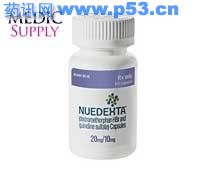制造商:
Avanir制药
类药物:
竞争力的NMDA受体拮抗剂和sigma - 1受体激动剂+ CYP2D6的抑制剂。
活性成分(S):
氢溴酸右美沙芬20毫克,硫酸奎尼丁10毫克;胶囊。
指示(S):
治疗假性影响(PBA)。
药理学:
右美沙芬(DM)是一个Σ- 1受体激动剂和竞争力的NMDA受体拮抗剂。奎尼丁增加竞争力的抑制CYP2D6的,催化一个主要的生物转化途径,为DM DM的血浆水平。机制,其中DM施加其影响在PBA的是未知之数。
临床试验:
PBA基本的肌萎缩性脊髓侧索硬化症,多发性硬化症患者的一项研究显示Nuedexta疗效。患者随机接受Nuedexta,DM HBR 30mg/quinidine硫酸10毫克,或安慰剂。主要结果测量,笑或哭的情节,在每个DM /奎尼丁手臂与安慰剂相比,无统计学显着降低。次要终点为神经研究不稳量表(CNS - LS)的,3个项目7项自我报告的问卷调查,评估哭和4评估笑声中心。 CNS - LS分析的基础上84日和基线的平均得分之间的差异,也统计学意义在每个DM /奎尼丁手臂,与安慰剂相比。
两项研究进行使用较高的剂量组合(DM HBR 30mg/quinidine硫酸30毫克)提供Nuedexta疗效的证据。
法律分类:
接收
成人:
≥18岁:7天每天1粒,然后(在第8天起)1胶囊,每12小时。重新评估定期。
儿童:
<18岁:不推荐。
禁忌(S):
奎尼丁,奎宁,甲氟喹。奎宁,甲氟喹,奎尼丁诱导的血小板减少症,肝炎,骨髓抑制,狼疮样综合征的历史。在14天的单胺氧化抑制剂。 QT间期延长。先天性长QT综合征。尖端扭转型的历史。心脏衰竭。药物延长QT间期和CYP2D6的底物(如甲硫达嗪,匹莫齐特)。完成房室传导阻滞,W / O型心脏起搏器,或完全房室传导阻滞的风险。
警告/注意事项:
停止奎尼丁相关的血小板减少症发生(继续使用可能会引起致命的出血);不重新启动。心电图QT间期延长和尖端扭转型(如,随之而来的延长QT间隔的药物,或强烈或中度CYP3A4抑制剂,左心室肥大,LVD)的风险:在基线和第一剂量后3-4小时;重新评估心电图如果风险心律失常的因素(如电解质异常,心动过缓,QT间期异常家族史)在治疗过程中的变化。正确的低钾血症,低镁血症开始之前。停止,如果心律失常发生。重症肌无力。考虑CYP2D6的弱代谢基因型。严重肾功能或肝功能损害。怀孕(部件C)。哺乳的母亲。
相互作用(S):
见禁忌。可能会导致与随之而来的SSRIs类药物(如氟西汀)或抗抑郁药(如氯丙咪嗪,丙咪嗪) - 羟色胺综合征。母体药物和/或代谢物的形成故障的积累,可能会减少,随之而来的CYP2D6的底物的安全和/或疗效;调整CYP2D6的底物的剂量或使用替代治疗。伴随地昔帕明,帕罗西汀:减少这些药物的剂量,调整基于响应。监视器地高辛;可能需要减少剂量。添加剂的中枢神经系统的影响与酒精。
不良反应(S):
胃肠不适,头晕,咳嗽,乏力,外周水肿,尿路感染,流感,增加γ-谷,胀气,血小板减少,过敏,抗胆碱作用,肝炎(停止,如果发生)。
如何提供:
CAPS - 60
最后更新:
2011年6月16日
NUEDEXTA
Manufacturer:
Avanir Pharmaceuticals
Pharmacological Class:
Uncompetitive NMDA receptor antagonist and sigma-1 agonist + CYP2D6 inhibitor.
Active Ingredient(s):
Dextromethorphan HBr 20mg, quinidine sulfate 10mg; capsules.
Indication(s):
To treat pseudobulbar affect (PBA).
Pharmacology:
Dextromethorphan (DM) is a sigma-1 receptor agonist and an uncompetitive NMDA receptor antagonist. Quinidine increases plasma levels of DM by competitively inhibiting CYP2D6, which catalyzes a major biotransformation pathway for DM. The mechanism by which DM exerts its effects in PBA is unknown.
Clinical Trials:
The efficacy of Nuedexta was shown in one study in PBA patients with underlying amyotrophic lateral sclerosis or multiple sclerosis. Patients were randomized to receive Nuedexta, DM HBr 30mg/quinidine sulfate 10mg, or placebo. The primary outcome measure, laughing or crying episodes, was statistically significantly lower in each DM/quinidine arm compared to placebo. The secondary endpoint was the Center for Neurologic Studies Lability Scale (CNS-LS), a 7-item self-report questionnaire with 3 items assessing crying and 4 assessing laughter. The CNS-LS was analyzed based on the difference between the mean scores on day 84 and baseline, and was also statistically significantly lower in each DM/quinidine arm compared to placebo.
Two studies conducted using a higher dose combination (DM HBr 30mg/quinidine sulfate 30mg) provided evidence of Nuedexta efficacy.
Legal Classification:
Rx
Adults:
≥18 years: 1 capsule daily for 7 days, then (starting on Day 8) 1 capsule every 12 hours. Reevaluate periodically.
Children:
<18 years: not recommended.
Contraindication(s):
Concomitant quinidine, quinine, or mefloquine. History of quinine, mefloquine, or quinidine-induced thrombocytopenia, hepatitis, bone marrow depression, lupus-like syndrome. Within 14 days of MAOIs. Prolonged QT interval. Congenital long QT syndrome. History of torsades de pointes. Heart failure. Drugs that prolong QT interval and are CYP2D6 substrates (eg, thioridazine, pimozide). Complete AV block w/o pacemaker, or risk of complete AV block.
Warnings/Precautions:
Discontinue if quinidine-related thrombocytopenia occurs (continued use may cause fatal hemorrhage); do not restart. Risk of QT prolongation and torsades de pointes (eg, concomitant drugs that prolong QT interval or that are strong or moderate CYP3A4 inhibitors, left ventricular hypertrophy, LVD): do ECG at baseline and 3–4 hours after 1st dose; reevaluate ECG if risk factors for arrhythmia (eg, electrolyte abnormality, bradycardia, family history of QT abnormality) change during treatment. Correct hypokalemia, hypomagnesemia before starting. Discontinue if arrhythmias occur. Myasthenia gravis. Consider genotyping for poor metabolizers of CYP2D6. Severe renal or hepatic impairment. Pregnancy (Cat. C). Nursing mothers.
Interaction(s):
See Contraindications. May cause serotonin syndrome with concomitant SSRIs (eg, fluoxetine) or TCAs (eg, clomipramine, imipramine). Accumulation of parent drug and/or failure of metabolite formation may decrease safety and/or efficacy of concomitant CYP2D6 substrates; adjust dose of CYP2D6 substrate or use alternative treatment. Concomitant desipramine, paroxetine: reduce dose of these drugs, adjust based on response. Monitor digoxin; may need to reduce dose. Additive CNS effects with alcohol.
Adverse Reaction(s):
GI upset, dizziness, cough, asthenia, peripheral edema, UTI, flu, increased gamma-glutamyltransferase, flatulence; thrombocytopenia, hypersensitivity, anticholinergic effects, hepatitis (discontinue if occurs).
How Supplied:
Caps—60


